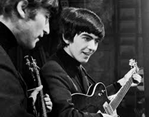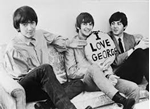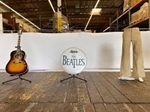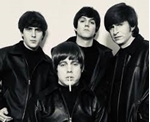- Register
- Log in to Tune-In
- Wishlist (0)
-
Shopping cart
(0)
You have no items in your shopping cart.
Beatles News

As Olivia Harrison remembers, her future husband, George, drove himself to work on the first day on his new job. It was October 1974, and George Harrison had flown to Los Angeles to visit the offices of the record label he’d just launched. The only problem was that no one had organized a welcoming party for him, but Olivia — then Olivia Arias, newly hired to work on the project — dashed out to the parking lot to greet him. “I thought somebody should,” she says. “He drove onto the lot by himself in this little car, and I thought, ‘Jeez, this is a big day in his life,’ and I went outside and said, ‘Welcome!’ He said, ‘What’s going on?’ He was very excited, but it was just me.”
In many ways, the story befits Harrison: Among his fellow Beatles, he was always the most low-key and publicity averse — the so-called quiet Beatle who also had a sly sense of humor. But his life after the band’s breakup was far from quiet; the early-to-mid-Seventies were some of the most creative and bustling years of his career. He went solo as soon as the group disbanded in 1970, organized the all-star Concert for Bangladesh at Madison Square Garden, a details

George Harrison was a true legend, both as a Beatle and as a solo artist. When he first began his solo career, some feared he wouldn’t find the success his bandmates had. However, he became a huge star in his own right.
Has his music lasted? Yes. In fact, fans still cared about his song “My Sweet Lord” over thirty years after its original release. Here’s how the tune hit number-one so long after it first hit the airwaves.
John Lennon and George Harrison on set of a show at Alpha Television Studios, Aston, Birmingham | David Farrell/Redferns
The Guardian reports George sadly passed away of cancer on Nov. 29, 2001. This created a huge demand for his record label, EMI, to rerelease is most iconic hit, “My Sweet Lord,” as a single. According to the Official Charts Company, “My Sweet Lord” originally hit #1 in the United Kingdom in 1971. Despite fan demand for a rerelease of the single, it didn’t happen right away.
Source: cheatsheet.com
details
The movie Yesterday—which airs on HBO tonight at 8 p.m. ET—might not be a perfect movie for film lovers, but for Beatles lovers, it’s nothing short of catnip. For one thing, the film—which is about a young musician who suddenly finds himself in a world where no one remembers the Beatles—is chock-full of Beatles songs. Like with Bohemian Rhapsody, Rocketman, and the rest of the recent jukebox movies, it’s hard not to love a movie that’s constantly playing your favorite songs.
For another, the Yesterday twist ending delivered Beatles fans a visual they’ve always longed to see: John Lennon in his 70s. Here’s how it happens: Yesterday—which was directed by Danny Boyle and written by Richard Curtis—is about Jack Malik (Himesh Patel), who becomes a famous musician using the Beatles’ music after he realizes he’s the only one who remembers the world’s most famous band. But soon, Jack starts running out of Beatles songs that he remembers how to play. As he becomes more and more famous, he also learns more and more about this weird Beatle-less alternate universe. One side effect? John Lennon never became a world-famous celebrity who was murdered a details

On April 18, 2020 one of the greatest solo debuts in rock history, Paul McCartney's McCartney, will receive a special 50th anniversary release in a limited-edition half-speed mastered vinyl pressing for Record Store Day.
Originally released in April 1970, one month before The Beatles' swansong Let It Be, McCartney saw Paul getting back to basics. Writing every song and playing every instrument (with backing vocals from Linda McCartney), the eponymous album represented a creative rebirth, bursting with new ideas, experiments, playfulness and freedom. Sonically, McCartney's bare-bones home recording aesthetic imbued the album with an authentic lo-fi spirit, a much sought after sound that continues to retain a contemporary edge 50 years on.
Source: prnewswire.com
details
“Got My Mind Set on You” was one of the biggest hits of George Harrison’s post-Beatles career. What many fans don’t know is it’s a cover of a song from the 1960s. The Beatles could have released their own rendition of the track during their prime.
However, it was not to be. Instead, George released his version of the song in the 1980s to great success. Here’s why the Beatles passed on “Got My Mind Set on You.”
According to The Independent, George became the first Beatle to visit the United States in 1963. He traveled to the country to see his sister, Louise, in Benton, Illinois. Salon reports that, while he was there, he picked up several records.
Among the records were some of Bobby Bland’s music, Booker T and the MGs’ first album, Green Onions, and James Ray’s 1962 debut album. George felt the latter was terrible. However, he enjoyed one song from it: “I’ve Got My Mind Set on You.”
Source: cheatsheet.com
details
There’s a Beatles song for every situation in life. ‘Let It Be’ will comfort you when you’re down, ‘Yellow Submarine’ rekindles the spirit of youth, and ‘I Am the Walrus’ underlines the wonders of the imagination. But do you know which Beatle sang all of these songs?
The question “who’s your favourite Beatle?” is an enduring discussion topic at BBQs and dinner parties. For more serious fans, it’s also a litmus test for how well they’ll mesh with someone.
The Beatles’ stylistic versatility brings eternal freshness to their 13-album catalogue. And the fact all four members performed lead vocals gives the band a multi-dimensionality rarely seen in rock music.
Paul McCartney’s generally regarded as the pop guy. He’s got endless melodic fuel, can belt out a monster chorus, and is prone to a bit of silliness. John Lennon, while no slouch in the pop department, was known for his more emotionally revealing contributions to the band’s albums. Lennon’s nasal vocal tone was never a hindrance either – he could scream and shout just as well as he could perform tender, heart-baring ballads.
Source: details

Harry Styles revealed his admiration for The Beatles star Paul McCartney in an interview with Howard Stern, calling him “one of the greatest songwriters of all time”. The Falling singer recalled his wonder after seeing McCartney perform live at London’s O2 in December, saying he was blown away by the show.
“He clearly just loves it,” he explained. “You’re like, who ultimately do you want to be at the end of the day?
“You don’t want to be the guy who died. You don’t want to be the guy who’s like whacked out on drugs.
“You want to be the guy who’s 70 and playing for three hours because he can and he wants to and everyone’s loving it and he’s having fun,” he continued.
“I found it super inspiring, that show, actually. He’s incredible.”
Source: Minnie Wright/express.co.uk
details
On April 18, 2020 one of the greatest solo debuts in rock history, Paul McCartney's McCartney, will receive a special 50th anniversary release in a limited-edition half-speed mastered vinyl pressing for Record Store Day.
Originally released in April 1970, one month before The Beatles' swansong Let It Be, McCartney saw Paul getting back to basics. Writing every song and playing every instrument (with backing vocals from Linda McCartney), the eponymous album represented a creative rebirth, bursting with new ideas, experiments, playfulness and freedom. Sonically, McCartney's bare-bones home recording aesthetic imbued the album with an authentic lo-fi spirit, a much sought after sound that continues to retain a contemporary edge 50 years on.
Source: finance.yahoo.com
details
The wooden stage of the small Liverpool venue where the Beatles performed before they rocketed to fame is going up for auction, along with Paul McCartney’s hastily scribbled notes for a studio recording of the hit song Hey Jude.
The stage and the lyrics are among 300 items of Beatles memorabilia being sold in New York on 10 April, including an annotated shooting script of the band’s 1967 Hello, Goodbye music video and an ashtray used by Ringo Starr at the Abbey Road recording studios in London, Julien’s Auctions said.
The stage was removed from Lathom Hall in the Beatles’ British home town of Liverpool, where the band gave its first advertised performance in May 1960 as the Silver Beatles. As the Beatles, but without Starr on drums, the band played there 10 more times until February 1961 – more than a year before the release of debut single, Love Me Do.
It is expected to sell for $10,000 to $20,000.
Source: theguardian.com
details
The Beatles meet Broadway by way of Bristol in a show that neither John, Paul, George nor Ringo ever saw.
Relive the Fab Four when Beatles for Sale invade the Paramount Center for the Arts in Bristol, Tennessee on Sunday. The show, “In My Life: A Musical Theatre Tribute to the Beatles,” features a chronology of The Beatles’ career as related in songs and a storyline.
“It starts when they met Brian Epstein, their manager, at the Cavern Club,” said Joshua Jones, who plays Paul McCartney in the Las Vegas-based group Beatles for Sale.
Essentially, “In My Life” relates the career of the Beatles through the eyes of Epstein. Attendees can observe the lads from their musical infancy at Liverpool, England’s Cavern Club through their final performance atop the Apple building in London.
Screened backdrops replicate particular scenes, including New York’s Shea Stadium, a site from the Beatles’ tour of America in 1965.
Source: TOM NETHERLAND | SPECIAL TO THE HERALD COURIER

Last year we reported on the reunion of Paul McCartney and Ringo Starr for a John Lennon tribute.
The two remaining Beatles reunited to record a cover of Grow Old With Me, one of the final songs that John Lennon wrote before he was killed in 1980.
Lennon had written Grow Old With Me during writing sessions for his Grammy Award-winning final record Double Fantasy, right before he was shot in 1980. However, his bandmates only learned of the demos many years later.
Ringo Starr was introduced to the song by Jack Douglas, the producer behind Double Fantasy.
Speaking to the BBC, Ringo described: “I’d never heard about this track and I bumped into the producer, Jack Douglas. He said ‘Did you ever hear the John cassette?”
” (I said) ‘I don’t know what you’re talking about,'” Ringo continued. “He said ‘I’ll get you a copy.'”
Source: happymag.tv
details
The Beatles broke up in the early 1970s. Ever since, fans have wanted to hear new music from the Fab Four. In the 1990s, audiences got their wish – to a degree.
The release of the Beatles Anthology came with a few new tracks. Essentially these songs were John Lennon demos which were completed with the help of Paul McCartney, George Harrison, and Ringo Starr. One of these songs, “Real Love,” sparked controversy when BBC Radio 1 refused to play it. Here’s why Radio 1 thought the Fab Four weren’t worth their time.
First, a little background on “Real Love.” The Beatles Bible reports the track was composed by John in 1979. At different times, he gave the song the titles “Real Life” and “Real Love.” He recorded several demos of “Real Love” with differing lyrics. Years after John’s murder, the song was released on the soundtrack of the film Imagine: John Lennon.
However, Ultimate Classic Rock reports “Real Love” wouldn’t become a Beatles song until much later. Paul, George, and Ringo worked with producer Jeff Lynne on one of the demos to finish the track. Lynne said it was a challenge to work with John’s details

The official and verified Instagram page of The Beatles legend John Lennon has posted a rare photo and leaked a different hairstyle of him. We are used to seeing John Lennon with his long wavy hair and round glasses, but in this picture, we see him with his short hair and sporty style.
Also, this rare photo of him was taken by photographer Astrid Kirchherr, at Hamburger Dom Funfair, Heiligengeistfeld Feldstrasse in Hamburg, Germany, in November 1960. Here’s what the page captioned:
“Hamburg, 1960⠀
Photographer Astrid Kirchherr: ‘I didn’t have to tell them not to smile, they just knew. They only had to look straight into the camera. They were absolute professionals, even when it took a long time to get everything just right. No one got angry or said that they didn’t want to carry on.⠀I printed them 32 × 40cm, large, and gave each of them the group photo. John, Paul, and George also got their individual photographs. It was like giving a carousel to little children: they couldn’t believe it because they’d never had pictures that big. I don’t think John ever realized he was beautiful until he saw them.’⠀
Source: Berk Uykucuoglu/metalheadzone details

Paul McCartney’s recent appearances have always paid homage to his past. The singer’s contribution to music with the Beatles should rightly stand in the spotlight of any performance from Sir Paul. But for a while, the singer avoided looking back at the past.
Here we relive the tour that McCartney finally embraced his past and welcomed a host of Beatles hits to his setlist. This clip sees McCartney finally assimilating his solo career with his legendary band on his world tour.
During the seventies, following The Beatles disbandment and McCartney’s pursuit of solo glory, the singer stayed away from performing the Fab Four’s tunes. He did drop a few Beatles’ numbers during the Wings 1975-76 and 1979 tours, but for the most part they had been kept aside from the McCartney’s repertoire. On The Paul McCartney World Tour, that soon changed.
1989 would see McCartney take to the road for the first time since 1979 when the Wings tour ended. The singer had disbanded the group following a drugs bust in Tokyo in 1980 had left him feeling vulnerable while on the road. But that year would also see some other classic rock alumni take to the stage.
Source: faroutmagazine.co.uk< details

The 1970s were a time for the world’s most eccentric artists to shine. Andy Warhol was at the forefront of the art world, leading the pop-art visual movement in which a plethora of music icons often functioned as muse.
It’s no surprise that Warhol would cross paths with other artistic individualists of the time, and it was widely reported that he became close friends with John Lennon and Yoko Ono throughout the 1970s.
The three-way friendship of Warhol, Lennon, and Ono blossomed over many years, with a number of obscure photographs being taken of the trio getting up to no good.
What started as a two-way friendship between Warhol and Lennon grew even stronger when Lennon introduced his partner, Yoko Ono. A Japanese-American multimedia artist, Ono dwelled in a scene surrounded by other influential artists such as Dan Richter and Peggy Guggenheim. It appeared that her knowledge of art shared with Warhol and her understanding of music due to her involvement with Lennon helped to create a multi-faceted friendship which, of course, was fuelled by their shared and differing artistic visions.
Source: happymag.tv
